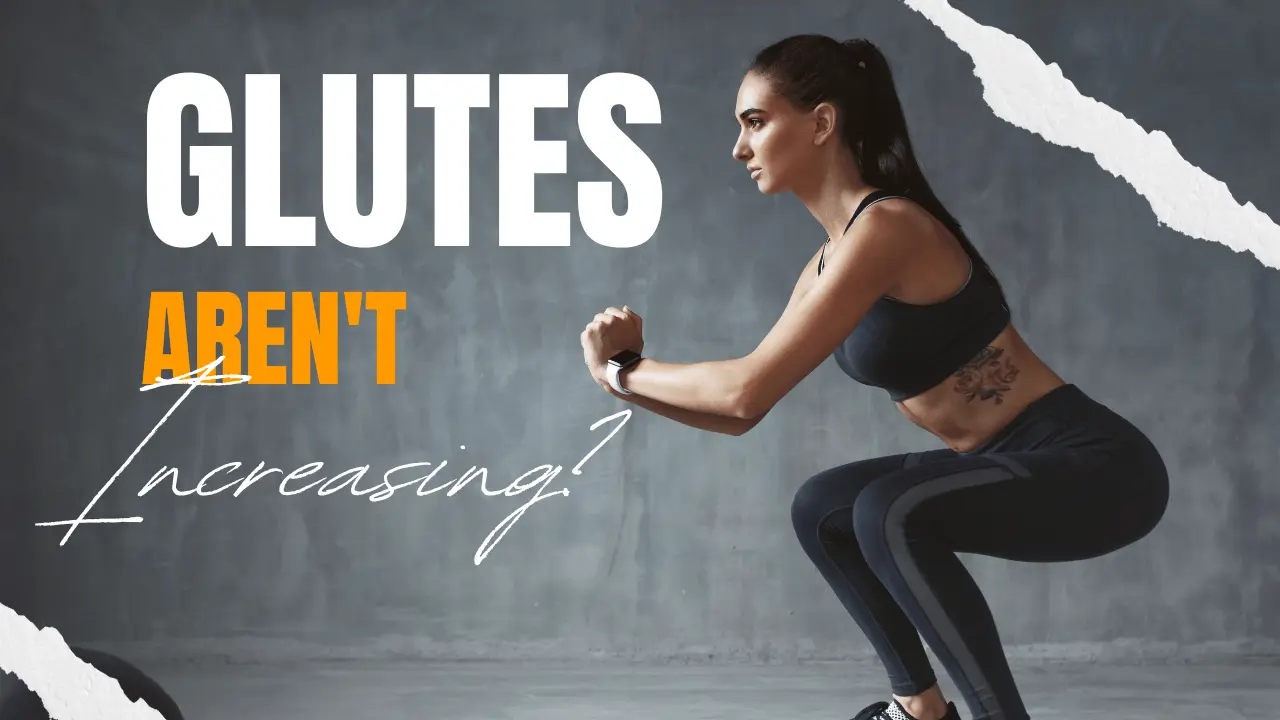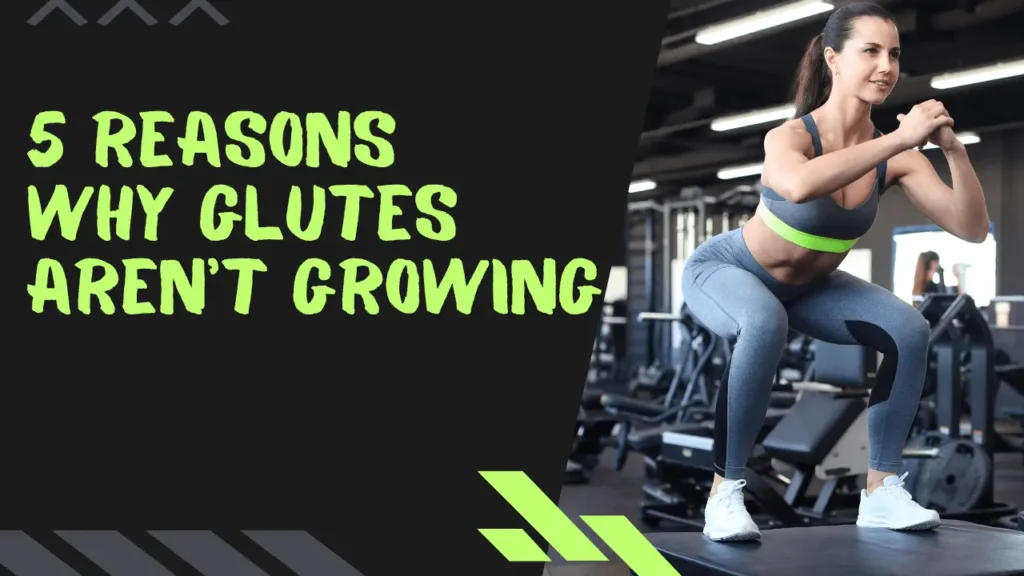5 Reasons Why Your Glutes Aren’t Growing (And How to Fix It)

Glutes are one of the most important parts of the human body. Training these muscle groups will eventually give you better mobility and endurance and help in power generation. But training these muscle groups can be quite hard, or even in some cases you might be training this muscle group but aren’t seeing the progress you hoped for; you’re not alone. Well, you are not alone; many people feel stuck in their lower body, wondering why their glutes aren’t shaping up the way they envisioned.
In this guide, we will discuss 5 common reasons why your glutes might not be growing and not forget how to fix them. These tips are practical, effective, and based on real fitness experience.
Let’s get into it.

1. You’re Only Doing Compound Exercises
Believing that compound movements like squats and deadlifts are enough for muscle growth—indeed, they are undeniably powerful and quite essential for building strength, but your glutes need more movements to grow to their full potential.
Your glutes are made up of three muscles:
- Gluteus Maximus (the largest)
- Gluteus Medius
- Gluteus Minimus
Compound movements mostly target the gluteus maximus, leaving the medius and minimus under-stimulated unless you specifically train them.
The fix:
Add a balanced mix of both compound and isolation movements. For example:
- Gluteus Maximus: Hip thrusts, Romanian deadlifts (RDLs)
- Glute Medius: Reverse lunges, lateral band walks, cable kickbacks
- Gluteus Minimus: Fire hydrants, side-lying leg lifts
If you are not training all the glute muscles properly, you are leaving gains. Burnouts, accessory exercises, and isolation moves are just as important for full development.
2. You’re Not Varying Your Movements
Doing exercises like hip thrusts, lunges, and kickbacks can be great, but doing the same exact version of those exercises every single time might be limiting your growth.
Muscles respond best to variety in tension and movement angles. Performing variations of the same movement challenges your glutes in new ways and helps prevent plateaus.
The fix:
Take a basic exercise and apply small changes to it. For instance:
- Hip thrust variations:
- Standard hip thrust
- Cast hip thrust (shorter range, more tension)
- Pulse hip thrust (small pulses at the top)
Reverse lunge variations:
- Deficit reverse lunges
- Elevated reverse lunges
- Reverse lunges with a pause or pulse
You don’t need to reinvent a new routine for gains. Just modify how you apply tension, range of motion, and tempo. The subtle muscle confusion will technically make you grow faster without changing your workout too frequently.
3. You’re Not Applying Progressive Overload
The most important training principle for muscle growth is progressive overload, which simply put, is putting on some gains. Not increasing the challenge over time won’t give your muscle reasons to grow.
Always lifting the same weight, doing the same number of reps, and performing the same volume every single week, eventually you will quickly hit a plateau.
The fix:
You need to progressively overload your glutes using any of the following methods:
- Add more *weight** (e.g., increase 1–1.5 kg every week).
- Increase reps
- Increase sets
- Slow down the tempo (more time under tension).
- Shorten rest time between sets
Consistency is key, but progression is the engine that drives results. If you’re doing 10–12 reps of hip thrusts with ease, it’s time to bump up the resistance.
And remember: don’t fall into the trap of ego lifting. You don’t need to jump from 60 kg to 70 kg in a week. Small, consistent increases over time deliver long-term growth while keeping your form safe and recovery manageable.
4. You’re Training Too Hard (Without Rest)
Yes, you heard that right. More is not always better.
One of the most common mistakes, especially among women who desire faster results, is always keeping training their glutes or legs every single day. But muscles don’t do much; they also need rest. Thus, a rest day is a must for recovery.
Overtraining your glutes without adequate rest can lead to:
- Fatigue Poor performance
- Lack of muscle growth
- Risk of injury
If you’re doing five or six exercises in one leg session and hitting failure too soon, chances are you’re doing too much volume and not training effectively.
The fix:
You should follow 2-3 well-structured leg sessions every single week. On each day, add 5-6 exercises focused on a mix of isolation and compound movements.
You can vary your focus like this:
- Day 1: Gluteus Maximus (heavy hip thrusts, RDLs)
- Day 2: Glute Medius & Minimus (Lunges, lateral movements)
- Day 3 (optional): Glute activation + hypertrophy (light weights, higher reps)
Also, aim for technical failure, not absolute failure. What’s the difference?
- Absolute failure: You physically can’t do another rep, even if offered a million dollars.
- Technical failure: You’re close to your limit, but your form is starting to break down.
Focusing on technical failure ensures you’re pushing your limits without burning yourself out or compromising form.
5. You’re Not Prioritising Recovery and Nutrition
Following all the above-mentioned things properly still does not get dream results. The thing is, if you are not fuelling your body properly or probably not sleeping enough, your glutes won’t grow.
Recovery includes:
- Sleep (at least 7–9 hours a night)
- Nutrition (especially protein intake)
- Hydration
- Stress management
The fix:
- Protein: Aim for 1.6–2.2 grams per kg of body weight daily to support muscle repair and growth.
- Carbs: Don’t fear them—they fuel your workouts and help recovery.
- Sleep: Make sure you’re getting quality rest so your muscles can rebuild.
- Rest Days: Take at least 1–2 full days off from lower body training.
Remember, you can focus on your training, but along with training, you must need food and proper sleep.
Final Thoughts: Trust the Process
There’s absolutely nothing wrong with wanting to grow your glutes. Whether it’s for confidence, strength, aesthetics, or all of the above.
Here’s a quick recap of the five most common reasons your glutes aren’t growing:
- You’re relying too much on compound movements.
- You’re not changing up your exercise variations.
- You’re skipping progressive overload.
- You’re overtraining without enough rest.
- You’re ignoring recovery and nutrition.
Fix these, and you’ll start seeing the glute gains you’ve been working for.



0 Comments